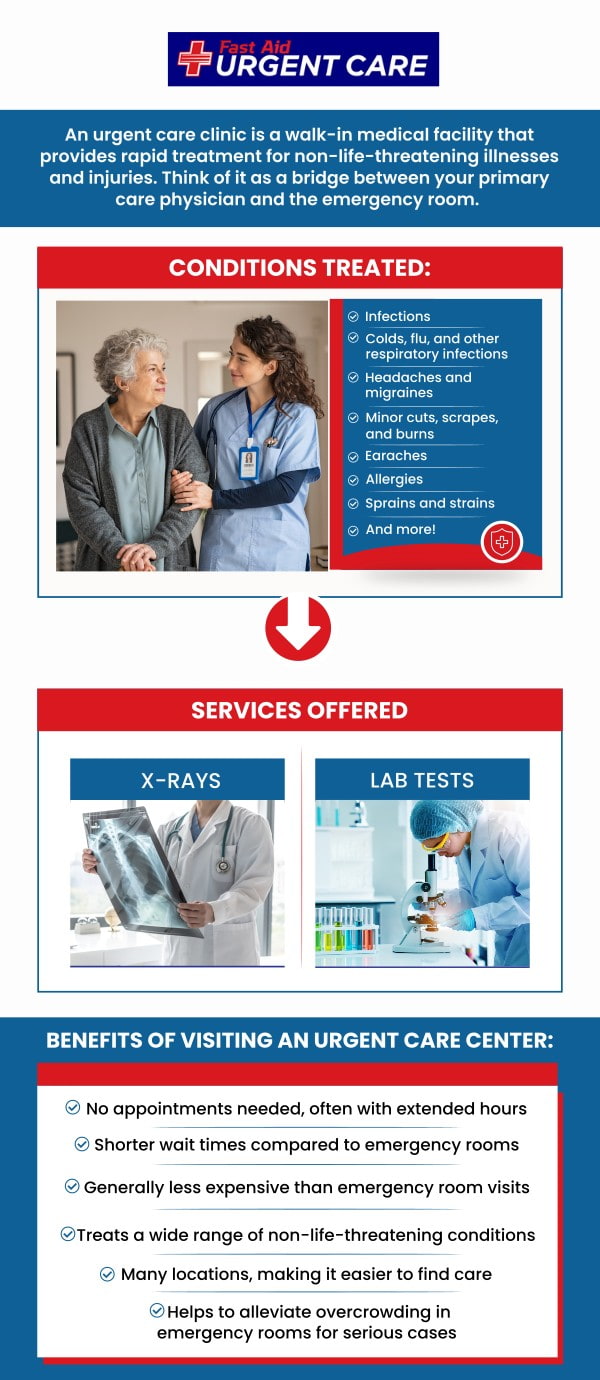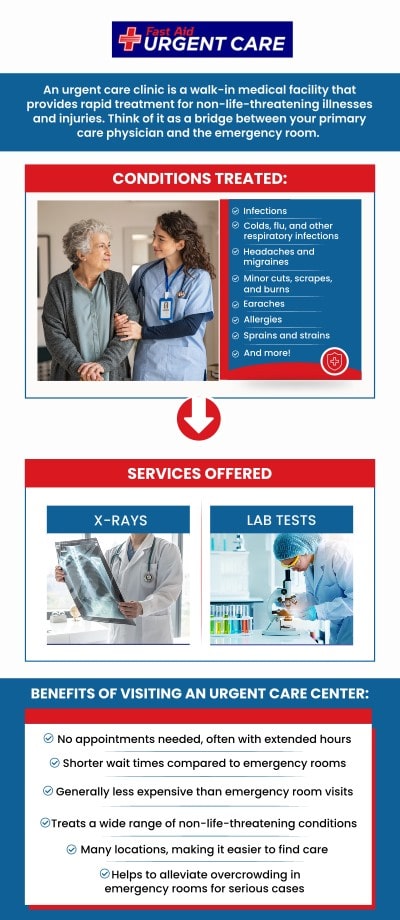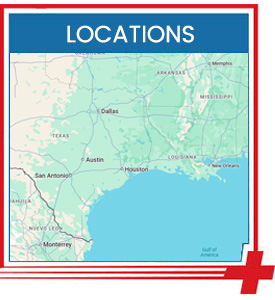When Should You Go to Urgent Care vs ER?
Emergency care is meant to address the most serious and life-threatening health issues, while urgent care is meant to address urgent, same-day issues that are not serious. If you are suffering from a non-life-threatening condition but require immediate care, visit Dr. Curtis Grote, MD, and his team at Fast Aid Urgent Care to receive comprehensive treatment and care for your medical needs. For more information, contact us or schedule an appointment online. We have convenient locations to serve you in Bulverde Rd San Antonio TX, Bastrop TX, Alamo Ranch San Antonio TX, La Grange TX, Leon Springs San Antonio TX, New Braunfels TX, Potranco Road San Antonio TX, and Dripping Springs TX.




Table of Contents:
What is the difference between urgent care and emergency care?
When would a patient utilize Urgent Care versus an emergency room?
Is it cheaper to go to urgent care or ER?
What diseases and injuries require the most immediate medical attention?
There is a distinct difference between urgent care and emergency care. Emergency care is meant to address the most serious and life-threatening health issues, while urgent care is meant to address urgent, same-day, non-life-threatening issues. Emergency care is available 24/7, as are some urgent care clinics, however, several urgent care clinics are open 7 days a week with extended hours. Some examples of health concerns that should be addressed at urgent care include injured limbs that may be sprained or broken; cuts that will not stop bleeding; dehydration; serious illnesses or infections; injuries from falls or slips other than head injuries; and other non-life-threatening trauma. Some examples of emergency care include severe burns; severe allergic reactions; major trauma; chest pain or difficulty breathing; severe headaches with confusion; strokes or heart attacks; and unconsciousness with the inability to wake. If your medical issue is not life-threatening, visit your nearest urgent care clinic, Fast Aid Urgent Care. If you are experiencing a life-threatening issue, then call 911. Do not attempt to drive to emergency care, an ambulance ride will provide a faster trip. Additionally, when you call an ambulance, within minutes you are in the hands of good care with paramedics who will monitor your condition, and, if necessary, they can help deliver life-saving medical care should your condition worsen on the way to the hospital. For those who are experiencing an urgent mental health matter, a call for help should be made to 911 or go to the nearest emergency room.
A patient will use urgent care in non-life-threatening situations. These include vomiting, urinary tract infections, sprains or joint pain, diarrhea, earache, skin conditions, cuts and minor burns, and back or muscle pain. The emergency room is more for severe medical concerns that involve uncontrolled bleeding, shortness of breath, severe abdominal pain, pneumonia, head injuries, chest pain or pressure, and a compound fracture (the bone that protrudes through your skin). At urgent care, patients are seen on a first-come, first-served basis, and urgent care clinics are staffed with doctors, physician assistants, nurses, and nurse practitioners. Urgent care clinics can also conduct and order basic lab and imaging tests, like X-rays, to help them offer diagnoses and develop the right treatment plans for patients. Urgent care clinics mainly have set hours, are normally less expensive, and boast much shorter wait times than emergency departments.
If you have a minor condition, like fever, flu symptoms, allergic reactions, minor cuts, broken bones, or bites, then urgent care clinics are much better for cost and time. If, however, you are experiencing a stroke, heart attack, electrical shock, or severe burns, then utilizing the services and resources at an ER is a much better choice. Urgent care clinics are equipped with x-ray machines, lab testing, and cutting-edge equipment and technology that is needed for treating medical conditions ranging from simple things like flu shots or blood sugar tests to more sophisticated treatments like casting broken bones. Urgent care clinics are also covered by insurance and the average cost per patient is about $100 to $150. This is far cheaper than the cost of ER, which, on average, is approximately $1500. It is important to highlight that several ER visits can be less expensive, depending on the medical issue, but in all, it costs significantly less to visit an urgent care clinic.
Injuries and diseases that need immediate medical attention include bleeding that won’t stop, diabetic attacks, changes in mental status, coughing up or vomiting blood, severe abdominal pain, swallowing a poisonous substance, severe pain anywhere in the body, and sudden dizziness or change in vision or weakness. Additionally, you will need immediate medical attention for a head or spine injury, a feeling of committing murder or suicide, loss of consciousness, choking, chest pain, a deep or large wound, burns or smoke inhalation, sudden injury from a motor vehicle accident, serious burns, and near drowning.
If you need urgent care, then you have come to the right place. Fast Aid Urgent Care is here to help treat non-life-threatening medical conditions. For more information, contact us or schedule an appointment online. We serve patients from Bulverde Rd San Antonio TX, Windcrest TX, Selma TX, Bastrop TX, Paige TX, Smithville TX, Alamo Ranch San Antonio TX, Leon Valley TX, Helotes TX, La Grange TX, Rabbs Prairie TX, Halsted TX, Leon Springs TX, Fair Oaks Ranch TX, Cross Mountain TX, New Braunfels TX, Hunter TX, Zorn TX, Potranco Road San Antonio TX, Rio Medina TX, Rolling Oaks Estates TX, Dripping Springs, TX, Saddletree Ranch TX, and Belterra TX.

Additional Services You May Need
▸ Urgent Care
▸ Walk-in Family Care
▸ Children’s Health
▸ Sports Physicals
▸ DOT Physicals
▸ Pediatric Urgent Care
▸ Immunization

Additional Services You May Need
▸ Urgent Care
▸ Walk-in Family Care
▸ Children’s Health
▸ Sports Physicals
▸ DOT Physicals
▸ Pediatric Urgent Care
▸ Immunization





